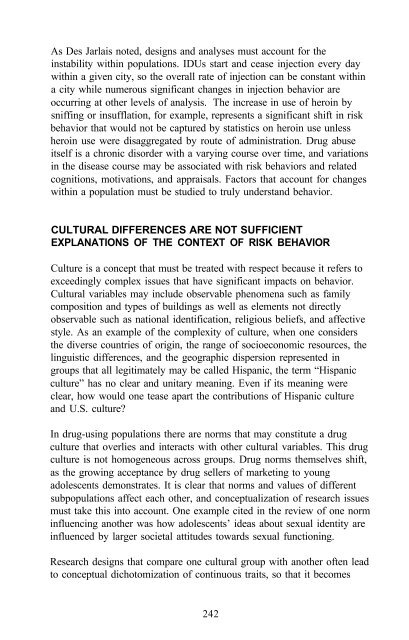The Context of HIV Risk Among Drug Users and Their Sexual Partners
The Context of HIV Risk Among Drug Users and Their Sexual Partners
The Context of HIV Risk Among Drug Users and Their Sexual Partners
You also want an ePaper? Increase the reach of your titles
YUMPU automatically turns print PDFs into web optimized ePapers that Google loves.
As Des Jarlais noted, designs <strong>and</strong> analyses must account for the<br />
instability within populations. IDUs start <strong>and</strong> cease injection every day<br />
within a given city, so the overall rate <strong>of</strong> injection can be constant within<br />
a city while numerous significant changes in injection behavior are<br />
occurring at other levels <strong>of</strong> analysis. <strong>The</strong> increase in use <strong>of</strong> heroin by<br />
sniffing or insufflation, for example, represents a significant shift in risk<br />
behavior that would not be captured by statistics on heroin use unless<br />
heroin use were disaggregated by route <strong>of</strong> administration. <strong>Drug</strong> abuse<br />
itself is a chronic disorder with a varying course over time, <strong>and</strong> variations<br />
in the disease course may be associated with risk behaviors <strong>and</strong> related<br />
cognitions, motivations, <strong>and</strong> appraisals. Factors that account for changes<br />
within a population must be studied to truly underst<strong>and</strong> behavior.<br />
CULTURAL DIFFERENCES ARE NOT SUFFICIENT<br />
EXPLANATIONS OF THE CONTEXT OF RISK BEHAVIOR<br />
Culture is a concept that must be treated with respect because it refers to<br />
exceedingly complex issues that have significant impacts on behavior.<br />
Cultural variables may include observable phenomena such as family<br />
composition <strong>and</strong> types <strong>of</strong> buildings as well as elements not directly<br />
observable such as national identification, religious beliefs, <strong>and</strong> affective<br />
style. As an example <strong>of</strong> the complexity <strong>of</strong> culture, when one considers<br />
the diverse countries <strong>of</strong> origin, the range <strong>of</strong> socioeconomic resources, the<br />
linguistic differences, <strong>and</strong> the geographic dispersion represented in<br />
groups that all legitimately may be called Hispanic, the term “Hispanic<br />
culture” has no clear <strong>and</strong> unitary meaning. Even if its meaning were<br />
clear, how would one tease apart the contributions <strong>of</strong> Hispanic culture<br />
<strong>and</strong> U.S. culture?<br />
In drug-using populations there are norms that may constitute a drug<br />
culture that overlies <strong>and</strong> interacts with other cultural variables. This drug<br />
culture is not homogeneous across groups. <strong>Drug</strong> norms themselves shift,<br />
as the growing acceptance by drug sellers <strong>of</strong> marketing to young<br />
adolescents demonstrates. It is clear that norms <strong>and</strong> values <strong>of</strong> different<br />
subpopulations affect each other, <strong>and</strong> conceptualization <strong>of</strong> research issues<br />
must take this into account. One example cited in the review <strong>of</strong> one norm<br />
influencing another was how adolescents’ ideas about sexual identity are<br />
influenced by larger societal attitudes towards sexual functioning.<br />
Research designs that compare one cultural group with another <strong>of</strong>ten lead<br />
to conceptual dichotomization <strong>of</strong> continuous traits, so that it becomes<br />
242
















